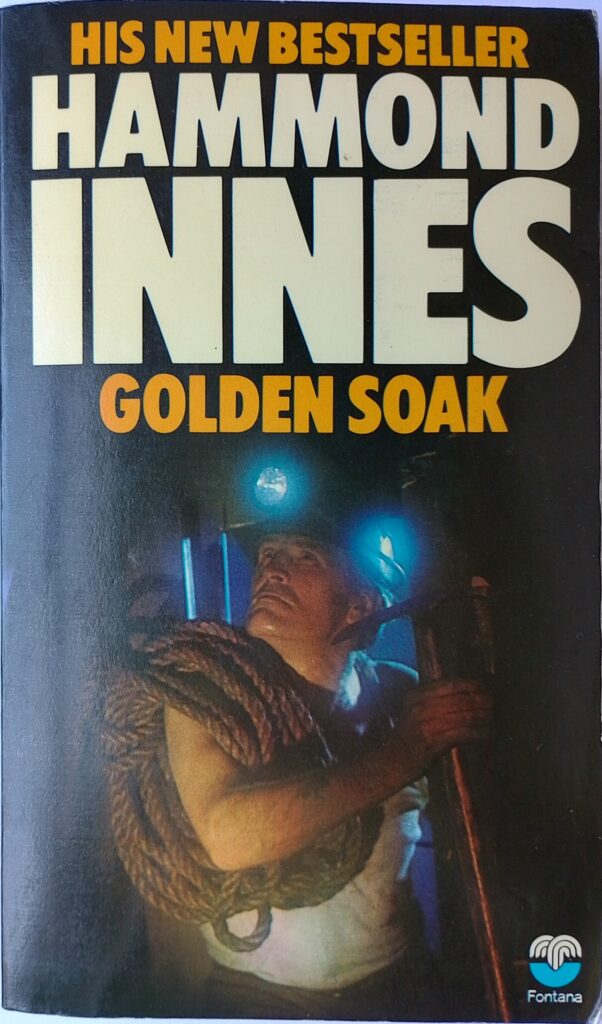Golden Soak by Hammond Innes
First published 1973. Fontana paperback, 1975, pp 286, c.115,000 words.
This is a classic Innes thriller, with all the usual ingredients except the sea, which in this case in replaced by the harsh deserts of Western Australia. The protagonist, Alec Falls, is a mining engineer, and at the start of the novel, a man who was prepared to wager all on a tin mine and lost as the seam ran out and his creditors caught up with him. His wife abandons him and so he burns his boats and flees to Australia to chance his luck again on a fresh mining venture. However he has almost no money and only a couple of contacts in the region. One is a young woman who he met once in England and who had talked of the beauty and bounty of the Pilbara and her father’s homestead. The other is a mining venture fixer, putting together prospectors and investors. It immediately becomes clear that opportunities for honest dealing are limited and that the land is brutally harsh.
Innes is excellent in evoking place: he always does his homework and has a fine turn of phrase: ‘The track was dusty, the grass sered brown, the hills shimmering in the burning sun. And the building all dilapidated, the woodwork starved and flaking paint.’ [p30] With simple sentences like that, Innes builds a clear picture. A problem that he faced was that the weather and the landscape hardly changes, despite a lot of rushing around. There are only so many ways to evoke intense heat, the incessant flies, the bleached and scrubby landscape. It is hard to sustain interest and build tension with such a desiccated backdrop.
Most of the characters stand up well as plausible and original human beings. Only the young woman’s father seemed a bit of a stock character: the grumpy old man. That is a harsh judgement on an important figure in the story, and a lot of his background is gradually filled in to try and explain the why, although it is not entirely convincing. What was striking was how Falls recognises very quickly that the old man, a widower, perceives any young man coming into contact with his daughter as a threat, someone who might take her away from him. The Culpin family make an interesting group: the father a rough prospector, out for anything he can grab regardless of who he has to tread on to get there. His wife, a decent but dried up and ineffectual woman, ground down (and beaten up). And their son, an idealistic young man, trying to live up to both his father’s and mother’s expectations, failing at both, but with his own, somewhat naïve, dreams and ambitions. Not everyone is crooked as one might expect them to be, and others are not quite as decent as one at first one believes. All good adventure yarn stuff. The daughter is stock Innes heroine: ‘She was smiling, coming towards me, a stocky, practical girl in a faded blue shirt and khaki slacks.’ [p24] She is lively, attractive but not beautiful, and good hearted. One suspects Innes’s wife was like that and that he deeply loved her.
As usual with Innes, the aboriginal people are sympathetically drawn and their plight at having white men seize their world recognised. Innes is at pains to articulate how well they understand and have a deep affinity for the land in which they have so long lived, and to which they are able to operate so much more effectively than the white men with all their vehicles and equipment. However, the language used may not be acceptable by 21st century standards: ‘…I hadn’t expected anything quite so black, so primitive looking’ [p24]. The roles women play are typical of thrillers of the period: secondary characters that don’t take part in the action except sometimes as motivation to male action. Most of the males expect women to cook for them. On the whole Innes has considerable respect for women and moves beyond thriller stereotypes of the femme-fatale, the arch-bitch, or there to serve mens’ appetites. In Innes some are strong characters, some weak, some good, some bad.
The story here bowls along, with some nice twists and turns. Sometimes there seemed to be a little too much rushing around for little purpose other than to add to the confusion and provide another landscape to be described. For a story named after a mine there is very little action underground. It is more about what the mine represents to the characters that is crucial.
May be this is not the finest Innes thriller, but an engaging story and an excellent escapist read.
Wikipedia biography of Innes: https://en.wikipedia.org/wiki/Hammond_Innes
Wikipedia summary of the book: https://en.wikipedia.org/wiki/Golden_Soak_(novel)
Others’ reviews of the book: https://www.goodreads.com/book/show/1265770.Golden_Soak?from_search=true&from_srp=true&qid=jLoPxThOf9&rank=1
© William John Graham, May 2023

